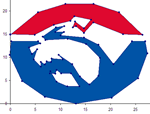Archives → Website
Letters and Numbers
Jeff of Webmaths points out a new Australian TV show, Letters and Numbers.
MathsKit Redesign
For a while, I’ve been developing a new look for this site and working out how to better connect my maths sites.
Investigating Scientific Notation
I’ve been trying to increase my use of the laptops with Year 9.
Chocolate Bar Graphs
Some chocolate discussion starters for looking at bar graphs: a series of chocolate bar graphs.
Drawing in Excel
A lesson for Year 9 students with DER laptops, or anyone really.
Evidence of doing anything
I think that each student using a netbook/laptop in your class presents some slightly different issues in Maths.
MathsKit
I recently created a site called MathsKit. Whilst I added some links to it on this site, I haven’t actually mentioned it yet.
Words for operations
I’ve been meaning to try ClassTools.net for a while. With ClassTools.net you can make interactive Flash games, from a range of templates, then save and share them.
End of term activities 5 - Patterns
Tomorrow is the last day of term… hurray! Here’s another end of term activity for use with your maths class.
Link: Western Bulldogs Number Plane Logo
If you’re looking for more number plane drawings, but lean towards AFL, then check out Jeff Trevaskis’ Western Bulldogs Number Plane Logo from his blog, Webmaths. Nice one Jeff!
NSWDER Tutorials
Brad Bennett, a student at a NSW DET Public High School, has made a site called DERNSW Tutorials – Tutorials for students and teachers using NSWDER laptops.
Classroom Icons
Having found this tip on elearnr.org Doug Belshaw’s blog about using PowerPoint:
Find graphics that represent things you do frequently in lessons (perhaps from clipart) and always use these when doing a similar activity. For example, a pen writing for when it’s time to start work or two people talking for discussion/group work. These help reinforce good habits and aid classroom management.
I went looking for some nice graphics to use.
Curriculum Support for DER
For NSW DET teachers, the Curriculum Support web-site has been updated with resources for the DER, i.e. the laptops being rolled out to Year 9 students.
10 Things Teachers Should Know Before 1:1
A quick read… some thoughts on 1:1 Computing from the “Free Technology for Teachers” blog: 10 Things Teachers Should Know Before 1:1.
Updated: Another new article: Ready for 1:1? Check this list before you answer from Darcy Moore a DP at Dapto H.S.
Google SketchUp
Google Sketchup is one of the applications bundled on the DER netbooks being rolled out into NSW Public High Schools in Term 3. But as it’s free, you can download it now for Windows XP/Vista & Mac OS X.
Dam Water
Still on capacity. With Australia having been in a drought since 2003 another interesting way to engage with the topic of capacity is to look at the water storage levels.
Maths Links
For a while I’ve been collecting and saving to a web-site maths objects to use with my classes. By objects I mean single activities, rather than a web-site of maths activities. I’ve been trying to take some of the many things I find and save to delicious and put a purpose to them – deciding that it’s something I could use with one of my classes.
Maths L4L Wiki
If you missed it in the comments to an earlier post. There are two new wikis you might want to keep an eye on as a NSW DET teacher (or any Maths teacher really).
Universcale
Depending on what they’ve previously experienced, students struggle with the immense scale of the universe (mind you, so do I).
End of term activities 4 - The Game of Hex
The last week of term begins next week…
The Big Picture
If you don’t have The Big Picture from boston.com in your RSS feeds, it’s time to add it. Alan Taylor regularly collects some fascinating photos together. This edition, At work.
Maths with Adam Spencer
Having even a basic but strong numeracy to you is something that really can give you a lot of advantage in life.
 The NSW DET have published their first e-zine for Parents which includes an interview with Adam Spencer (Breakfast radio presenter on ABC 702 and Mathematician) by James O’Loughlin. It’s a helpful discussion about Mathematics at school and how parents might help their kids.
The NSW DET have published their first e-zine for Parents which includes an interview with Adam Spencer (Breakfast radio presenter on ABC 702 and Mathematician) by James O’Loughlin. It’s a helpful discussion about Mathematics at school and how parents might help their kids.
Siftables, the toy blocks that think
This blog is about Maths teaching, however this year (as noted in an earlier post), I’m also teaching a computing subject: Information and Software Technology. Occassionally, I’ll post something that is more related to a computing subject than Maths, but hopefully everyone reading this blog will still find it interesting.
You Can Do Maths
The Australian Association of Mathematics Teachers (AAMT) recently created a web-site called “You Can Do Maths”. From the site:
The youcandomaths campaign encourages all young people and their families to appreciate the important role mathematics plays in many careers and everyday life.
Theatrical Aspect Ratio
Recently Dan Meyer posted his thoughts on the ideal maths textbook, which would actually be a digital archive of very interesting mathematical media
. This is a great idea, and whilst I don’t have a projector in my classroom yet (although fingers-crossed), it would be something that I would buy/subscribe to. Anyway, there was a challenge in this for me: being mindful of the media I consume and the world around me to collect digital bits and pieces that might help explain a mathematical concept (I commented on Dan’s blog that I missed the opportunity to take a picture of 3m³ of dirt I had delivered). The second, to my mind harder, challenge is to take that item and make a meaningful and engaging connection with a concept being taught in class.
Wild About Math!
I’m currently sorting through the many teaching blogs I subscribe to, trying to cull the list. The thing about Maths related blogs that tends to keep them in the list is that Maths teachers generally write more practical posts.
Searching Pi
The Search π website does just that, allows you to search the first 3.2 billiion digits of pi for a string of numbers.
Keeping organised
I’ve found that teaching is one of those jobs where you end up making “to-do” lists. Years ago, I was determined to do away with paper-based to-do lists chasing me around. I started using Backpack described as an “information organiser” — Gather your ideas, to-dos, notes, photos & files online.
Google Forms
Google have added a nice little feature to their online spreadsheet – the ability to collect information via an online form.
Lesson Starters
Lesson Starters is a page full of activities to start a mathematics lesson.
One I’ve used is Number Spiders, there’s even an overhead (PDF) ready to print. Keep it in your classroom for those days when you know the start of the lesson is going to be disrupted.
EAA Mathematics Resources
Here’s a nice page of resources for Mathematics teachers, published via the EAA (Educational Assessment Australia, UNSW).
New Subscribe to the …
MathsLinksemail newsletter
Get updates…
About
Simon Job — eleventh year of teaching maths in a public high school in Western Sydney, Australia.
MathsClass is about teaching and learning in a maths classroom. more→
Archive
Elsewhere
 @simonjob
@simonjob
updates via  @mathslinks
@mathslinks
Recently read/found.
Being a Vector is not Mutually Exclusive – Ringo Mok
maths vectorsInstagram
Gcf howie_hua maths


